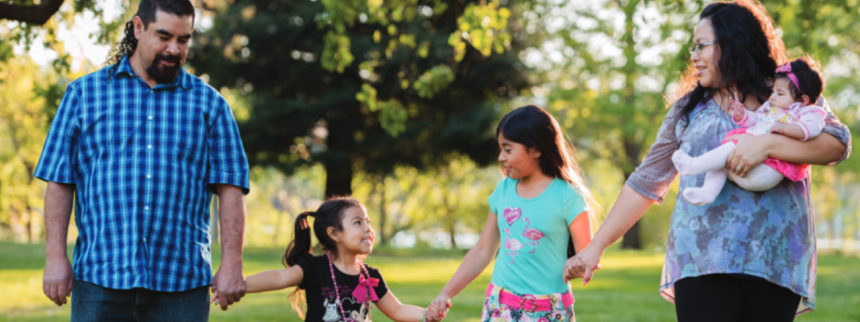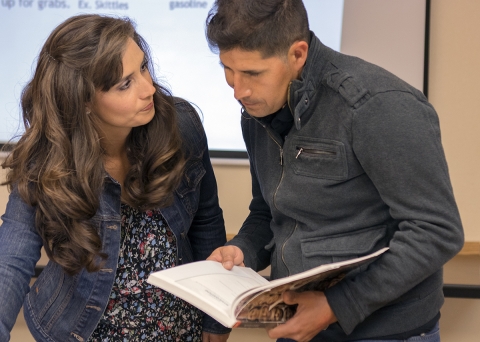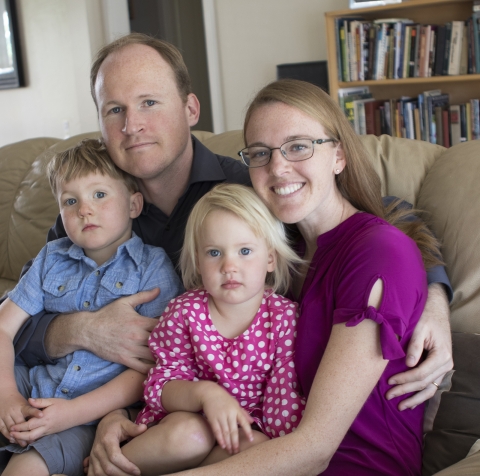
When Maria Saavedra De La O shares her faith and commitment to Natural Family Planning (NFP), she upholds the selfless sense of communion which defines the bonds of matrimony.
“It is a sacrament,” she says, always seeking the best ways and words to convey and renew the fullness of understanding and respect of the marriage covenant. “It is what God wants,” she continues with clear concern that Catholic teachings on marriage and family experience blatant contempt in the secular world today.
Maria, a member of Our Lady of Mercy Parish in Redding, remembers conversations four years ago with her then-pastor, Father Jonathan Molina.
“We had a video to show on NFP during marriage preparation classes, but there were no other local options for couples to learn more,” Maria explains, thinking back to 2014 and her journey to seek and complete training in 2016 to help couples embrace NFP.
Maria and her husband Fernando are the parish’s marriage preparation coordinators and practice, promote and instruct on the Billings Ovulation Method in both English and Spanish. They offer it as “the last class in a series of five” for marriage preparation. The Diocese of Sacramento requires all marriage preparation programs to include NFP content.
“I like that it has been taught all over the world,” Maria says, commenting on the ease and accessibility of the method. She describes it as “simple” and focused on learning about a woman’s fertility and specifically the ovulation cycle. The Billings Ovulation Method of America is the most common of what are termed single indicator methods. It observes a single indicator only – cervical fluid.
“You must chart correctly,” she insists, saying that a couple must know the system well but “anybody can do it.” She relates how even in regions where couples may not read or write, the method can be learned using symbols and colored stickers to aid in the charting process.
Years ago Maria and Fernando acknowledged an initial apprehension about whether NFP would work for them, but any anxieties gave way to faith. “It is what we believe to be right,” Maria says, confident in the love and joy they share with their daughters, Sophia, 9, Emily, 4, and Jazmin, who is 5 months old.
Maria admits that upon meeting couples she asks what they may already know about NFP. “Most think that it is not reliable,” she says, adding that “sadly, couples also believe it is a lot of work.” Her voice hints of frustration, but she knows the answer lies in education and outreach. “We need to bring this knowledge to couples,” she stresses, offering a resilient reply to undo the negative perceptions.
“We work to relate our Catholic views and how we are changed once we receive the sacrament of matrimony,” Maria says, affirming the importance of a valid sacrament open to the grace of God and representing the love of Christ and the church.
Andreya Arevalo, youth minister, wedding coordinator and marriage preparation coordinator at St. Mary Parish in Vacaville, seeks certification in the Creighton Model FertilityCare System (CrMS) so she can weave the NFP content into her other ministries. She is completing a 13-month internship program and will need to work with 18 couples before she completes her training in January.
She finds people “want the data” and data represents the key hallmark of CrMS. “It can be useful in identifying gynecological health and reproductive disorders,” she notes. The medically standardized system is similar to the Billings Method as a single indicator method, but the universal program requires specific materials and tools from the Pope Paul VI Institute in Omaha, Neb.
Andreya is currently instructing couples and has already offered an introductory session six times each year. She promotes the session to engaged and married couples but also indicates “anyone can attend,” sharing how a nurse came once, with curiosity and interest in sharing the information with other nurses.
Meghan and Colin Bardin of Presentation Parish in Sacramento reflect on their journey to be certified in NFP and the excitement they feel when given the opportunity to talk about how NFP blessed their marriage.
“It wasn’t hard to discern about this ministry for us as a couple,” Colin says, citing the encouragement of their own instructors during their marriage preparation and engagement. Meghan and Colin accepted the invitation to become a “teaching couple” for the Couple to Couple League late in 2015. They attended a unique training weekend opportunity with the League at that time, and then proceeded with a self-paced study and certification early in 2016.
“We teach couple to couple,” Meghan explains, sharing how husband and wife participate in the Sympto-Thermal Method. “It’s really an awesome format – especially for engaged couples – because it moves couples to the same page,” she notes, referring to the necessary and comprehensive need for communication every month.
“I appreciated teachers telling us ‘you will need a real reason for postponing children,’” Colin adds, elaborating on the degree of important discussion which brings a couple close. “Every month, I see how NFP facilitates our communication on health, family needs and financial matters,” he says, grateful for each opportunity to dialogue and pray.
“It really is about the present and what God is calling us to,” Meghan adds, content with how the couple is “empowered by communication.” The young family has two children – Daniel, 4, and Eileen, 2 and a half – and look forward to talking and teamwork as life unfolds. As an example, Meghan lives with scoliosis and NFP helped the couple address the sometimes daunting matters of back health. This reality led the couple to a physical therapy program to return Meghan to improved health.
“If postponing pregnancy occurs for an important reason like a health issue, we’re going to do all we can to attack that problem,” Colin says. “There was a lot of peace in that period of time because we felt like that was what we were meant to do,” Meghan adds.
The Sympto-Thermal Method is recognized as a multiple indicator method which charts three distinctive data points to arrive at a specific algorithm for fertility. Couples observe and chart cervical fluid, basal body temperature and cervical changes, and then employ boundaries for the cycle which depend on whether they seek to achieve or avoid pregnancy.
Meghan and Colin post the availability of their classes online and typically begin a new class every three months. They’re also planning to offer the first NFP class (of three in their series) as a component of the marriage preparation program at the Cathedral of the Blessed Sacrament.
“It is hard to find people who want to take the program,” Colin concedes, intent on the pathway via marriage preparation classes. He also adds that they are available to their own parishioners, and open to accommodate couples in their home, workplace or any venue that can be conducive to their discussion. They also offer a post-partum class and pre-menopause class.
“We pray for God to provide the people to come,” Colin says, recognizing an ongoing “spiritual battle” complete with societal traps at every turn.
“Once a couple starts learning NFP, they see how beautiful it is and how amazing God made us,” Meghan shares, hinting that the science balanced with theology makes it irrefutable. The Couple to Couple League approach also concludes the training with a short video presented by a priest who shares the gift of St. John Paul II’s Theology of the Body. Meghan emphasizes: “I cannot imagine a marriage without this.”
Learn more about NFP in the Diocese of Sacramento at www.scd.org/NFP
In photo above, Maria and Fernando Saavedra De La O of Our Lady of Mercy Parish in Redding, and their children, Sofia, Emily and Jazmin.



